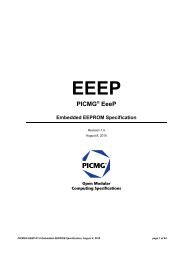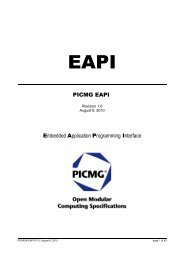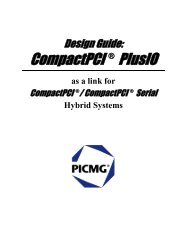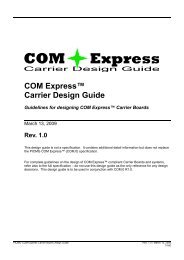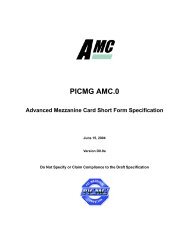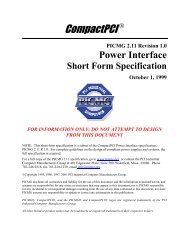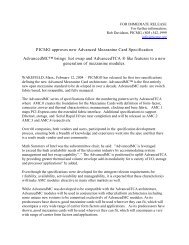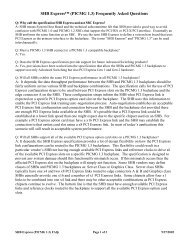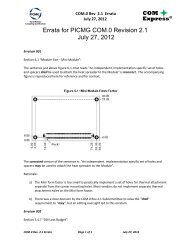PICMG 2.20, CompactPCI Serial Mesh Backplane
PICMG 2.20, CompactPCI Serial Mesh Backplane
PICMG 2.20, CompactPCI Serial Mesh Backplane
Create successful ePaper yourself
Turn your PDF publications into a flip-book with our unique Google optimized e-Paper software.
<strong>Mesh</strong> Topology<br />
FOR INFORMATION ONLY;<br />
DO NOT ATTEMPT TO DESIGN FROM THIS DOCUMENT<br />
There are many different ways to interconnect a mesh. The mesh defined in the full <strong>2.20</strong><br />
specification uses a “physical” channel arrangement. Each channel is physically associated<br />
with a slot.<br />
SLOT 1<br />
SLOT 2<br />
SLOT 3<br />
SLOT 4<br />
SLOT 5<br />
SLOT 6<br />
SLOT 1<br />
SLOT 2<br />
SLOT 3<br />
SLOT 4<br />
SLOT 5<br />
SLOT 6<br />
CHAN 1<br />
1-1<br />
2-1<br />
3-1<br />
4-1<br />
5-1<br />
6-1<br />
CHAN 1<br />
1-1<br />
2-1<br />
3-1<br />
4-1<br />
5-1<br />
6-1<br />
CHAN 2<br />
1-2<br />
2-2<br />
3-2<br />
4-2<br />
5-2<br />
6-2<br />
CHAN 2<br />
1-2<br />
2-2<br />
3-2<br />
4-2<br />
5-2<br />
6-2<br />
CHAN 3<br />
1-3<br />
2-3<br />
3-3<br />
4-3<br />
5-3<br />
6-3<br />
CHAN 3<br />
1-3<br />
2-3<br />
3-3<br />
4-3<br />
5-3<br />
6-3<br />
CHAN 4<br />
1-4<br />
2-4<br />
3-4<br />
4-4<br />
5-4<br />
6-4<br />
CHAN 4<br />
1-4<br />
2-4<br />
3-4<br />
4-4<br />
5-4<br />
6-4<br />
CHAN 5<br />
1-5<br />
2-5<br />
3-5<br />
4-5<br />
5-5<br />
6-5<br />
CHAN 5<br />
1-5<br />
2-5<br />
3-5<br />
4-5<br />
5-5<br />
6-5<br />
CHAN 6<br />
1-6<br />
2-6<br />
3-6<br />
4-6<br />
5-6<br />
6-6<br />
CHAN 6<br />
1-6<br />
2-6<br />
3-6<br />
4-6<br />
5-6<br />
6-6<br />
Figure 8: Square <strong>Mesh</strong> Topology<br />
Figure 9: The <strong>Mesh</strong> as a Hub<br />
Figure 8 illustrates that each channel is associated with a slot. Channel 2 in Slot 1 connects<br />
with Channel 1 in slot 2, and so on. This physical arrangement is symmetrical around the<br />
diagonal axis. Every connection to a specific slot is in the same physical location. It permits<br />
any slot to act as the hub for any subset of the mesh signals.<br />
Distributed Fabric Interfaces<br />
Each node in a distributed system can act as a node, as a switch, or both.<br />
As a node, a board may send all traffic to a specific channel without any<br />
content related switching. This is the simplest form of the fabric interface.<br />
The interface simply encapsulates the traffic into the desired protocol and<br />
sends it to a fixed port. The board in the slot corresponding to this<br />
channel becomes the switch for the traffic. If boards are hard wired for<br />
specific channels, the switch boards must be placed in specific slots.<br />
A node may contain a full population of serial interfaces and a multiplexer.<br />
This is the same as the previous example, but with the connectivity to<br />
allow any board to be provisioned in any slot.<br />
A node may implement a basic degree of channelization by sending traffic<br />
to different destinations based on different sources. A UTOPIA port<br />
address, or a SONET sub-channel may be the determining factor. All of<br />
LIU<br />
TM<br />
MUX<br />
SERDES<br />
<strong>CompactPCI</strong> <strong>Serial</strong> <strong>Mesh</strong> <strong>Backplane</strong> Short Form Specification




